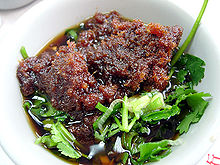Shacha sauce
 | |
| Place of origin | Chaoshan, China |
|---|---|
| Region or state | Chaoshan, Fujian, Taiwan |
Shacha sauce (Chinese: 沙茶; Pe̍h-ōe-jī: sa-te; also spelled sa cha sauce) is a savory, slightly spicy Chinese condiment used in Min Nan cuisine (primarily Teochew, Fujian, and Taiwanese). It is made from soybean oil, garlic, shallots, chilies, Chinese brill, and dried shrimp.[1][2] It is also sometimes sold as "Chinese barbeque sauce".[3][4]
Shacha sauce is used many different ways; as a soup base, a barbeque meat rub, a dipping sauce (for hot pot), or a seasoning for stir-fries. It is also included with instant noodles manufactured in Vietnam, in their own packet alongside packets of soup base, dried vegetables, or other seasonings.[5]
Origin[edit]
Shacha sauce is also known as sa-te in the Teochew and Hokkien dialects, reflecting its origin in the satay sauce introduced by expatriate Min Nan people returning to China from Southeast Asia.[6] During the 20th century, Chinese labourers from the Chaoshan region who worked in Southeast Asian countries (e.g., modern-day Malaysia and Indonesia) adapted satay sauce to local tastes, including the introduction of dried seafood.[6] Shacha is now quite different from the peanut-based satay sauce popular in Malaysia and Indonesia.[7] Following the Chinese Civil War, Chaoshan immigrants resettled in Taiwan and introduced shacha sauce to the Taiwanese culinary repertoire.[8][6] One in particular, Liu Lai-chin, a Tainan-based noodle shop owner originally from Chaoshan, created the iconic Bullhead brand (牛頭牌) of shacha sauce in 1958.[8][6] In the 1960s and 1970s, as beef consumption slowly gained cultural acceptance in Taiwan, shacha sauce became more popular among locals.[6]
See also[edit]
- List of Chinese sauces
- Siu haau sauce
- Peanut sauce
- XO sauce
- Shito - Similar condiment used in Ghana
References[edit]
- ^ Mary Kate Tate & Nate Tate (2011). Feeding the Dragon. Kansas City, Missouri, USA: Andrews McMeel Publishing Ltd. p. 270. ISBN 978-1-4494-0111-5. Retrieved 12 April 2012.
- ^ Acciardo, Kelli (2021-07-02). "Chefs Swear By These Under-the-Radar Asian Ingredients for Game-Changing Flavor". Parade: Entertainment, Recipes, Health, Life, Holidays. Retrieved 2021-09-26.
- ^ "How To Shop A Chinese Supermarket Like A Pro". LAist. 2020-01-24. Retrieved 2021-09-26.
- ^ Allen, Gary (2019-02-08). Sauces Reconsidered: Après Escoffier. Rowman & Littlefield. p. 102. ISBN 978-1-5381-1514-5.
- ^ "The secrets behind instant noodle seasoning sachets". VnExpress International. Retrieved 2021-09-26.
- ^ a b c d e Erway, Cathy (2021-04-14). "There Is No Substitute for Shacha Sauce". TASTE. Retrieved 2022-03-07.
- ^ "Sacha Sauce Goes Out to All My Umami Lovers". Bon Appétit. 5 November 2020. Retrieved 2021-07-04.
- ^ a b Tseng, Lin-Yi (2018-01-01). "An accidental journey: sha-cha sauce and beef consumption in Tainan since 1949". Social Transformations in Chinese Societies. 14 (2): 107–116. doi:10.1108/STICS-04-2018-0008. ISSN 1871-2673.

